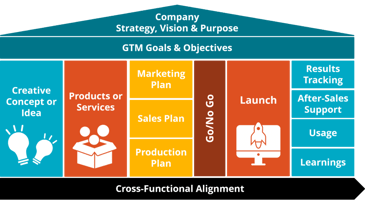Creating a successful go-to-market (GTM) plan is essential for introducing a product or service to...
Building a successful go-to-market (GTM) plan for a Tech AI company
 Building a successful go-to-market (GTM) plan for a Tech AI company involves several critical steps. Here's a comprehensive guide to help you create an effective GTM strategy:
Building a successful go-to-market (GTM) plan for a Tech AI company involves several critical steps. Here's a comprehensive guide to help you create an effective GTM strategy:
1. Market Research and Analysis
Objective: Understand your market, customers, and competition.
- Identify Target Market: Determine who your customers are, segment the market, and prioritize segments.
- Analyze Competition: Understand your competitors’ strengths, weaknesses, strategies, and market position.
- Customer Personas: Develop detailed profiles of your ideal customers, including their needs, pain points, and buying behavior.
2. Define Your Value Proposition
Objective: Clearly articulate what makes your AI product unique and valuable.
- Unique Selling Proposition (USP): Highlight the unique features and benefits of your AI solution.
- Value Proposition Statement: Create a concise statement that communicates the key value your product offers to customers.
3. Product Positioning and Messaging
Objective: Position your product effectively in the market and create compelling messaging.
- Positioning Statement: Define how you want your product to be perceived in the market relative to competitors.
- Key Messaging: Develop core messages that resonate with your target audience and align with your positioning.
4. Sales Strategy
Objective: Develop a strategy to drive sales and achieve market penetration.
- Sales Model: Choose the appropriate sales model (direct sales, channel sales, or a hybrid approach).
- Sales Team Structure: Define the structure and roles of your sales team.
- Sales Process: Develop a step-by-step process for lead generation, nurturing, closing deals, and post-sales support.
5. Marketing Strategy
Objective: Generate demand and awareness for your AI product.
- Marketing Channels: Identify the most effective channels (e.g., digital marketing, content marketing, social media, events).
- Content Strategy: Develop a content plan that includes blogs, whitepapers, case studies, and webinars to educate and engage your audience.
- Inbound and Outbound Marketing: Balance inbound strategies (e.g., SEO, content marketing) with outbound strategies (e.g., PPC, email campaigns).
6. Pricing Strategy
Objective: Set a pricing strategy that reflects the value of your AI product and market conditions.
- Pricing Models: Choose between subscription, usage-based, freemium, or one-time purchase models.
- Competitive Pricing Analysis: Benchmark your prices against competitors and adjust based on value differentiation.
- Discounts and Incentives: Create pricing tiers and offer discounts or incentives for early adopters.
7. Partnership and Alliances
Objective: Leverage strategic partnerships to enhance market reach and credibility.
- Identify Potential Partners: Look for partners that complement your product (e.g., technology partners, system integrators).
- Partnership Agreements: Develop mutually beneficial agreements outlining roles, responsibilities, and revenue sharing.
8. Go-To-Market Execution Plan
Objective: Create a detailed execution plan with timelines and responsibilities.
- Roadmap: Develop a timeline for key activities, milestones, and launch dates.
- Resource Allocation: Ensure you have the necessary resources (budget, team, tools) to execute your plan.
- Metrics and KPIs: Define key performance indicators (KPIs) to measure the success of your GTM plan (e.g., customer acquisition cost, customer lifetime value, market share).
9. Feedback and Iteration
Objective: Continuously improve your GTM strategy based on market feedback.
- Customer Feedback: Collect and analyze feedback from customers to identify areas for improvement.
- Performance Analysis: Regularly review KPIs and adjust your strategy based on performance data.
- Agile Approach: Be prepared to pivot and adapt your strategy as market conditions and customer needs evolve.
10. Legal and Compliance
Objective: Ensure your product and GTM activities comply with relevant regulations.
- Regulatory Requirements: Identify and comply with industry-specific regulations and standards.
- Data Privacy and Security: Implement robust measures to protect customer data and ensure compliance with data protection laws (e.g., GDPR, CCPA).
Conclusion
By following these steps, you'll be able to create a comprehensive go-to-market plan that positions your Tech AI company for success. Remember, the key is to remain flexible and responsive to market dynamics while staying focused on delivering value to your customers.



